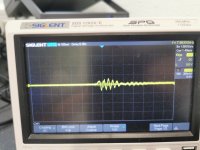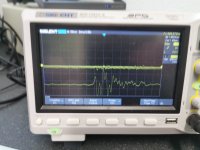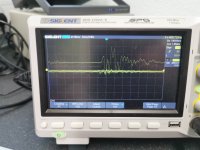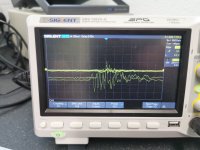What is the peak to peak amplitude and frequency of it?
Ultimately you have to go back to first principles with it. Isolate the power amp input and short it to the correct input ground and look and work on one channel at once. Any noise is either mains related whether on a rail or induced into the amp magnetically from the transformer or it is generated by the amp itself meaning its unstable and oscillating.
Your scope shot shows it perfectly aligned with the X axis but I see 49.93kHz on the display which is 1000 times higher than mains frequency.
Ultimately you have to go back to first principles with it. Isolate the power amp input and short it to the correct input ground and look and work on one channel at once. Any noise is either mains related whether on a rail or induced into the amp magnetically from the transformer or it is generated by the amp itself meaning its unstable and oscillating.
Your scope shot shows it perfectly aligned with the X axis but I see 49.93kHz on the display which is 1000 times higher than mains frequency.
so could we be looking at an old leaky disk cap causing a grounding issue or something like that,
Ive lost count on how many continuity checks ive done around the print, and can find anything wrong, but that doesnt mean there isnt of course.
Ive lost count on how many continuity checks ive done around the print, and can find anything wrong, but that doesnt mean there isnt of course.
I think something like a leaky cap is unlikely tbh.
I've no quick answer I'm afraid. I think you need to start afresh with it from the beginning and if this is the one where the lamp brightens at low values of Iq then you need to find out what is going there first.
I've no quick answer I'm afraid. I think you need to start afresh with it from the beginning and if this is the one where the lamp brightens at low values of Iq then you need to find out what is going there first.
I think it's a routing problem highlighted by the MOS registry.
years ago, I considerably modified a Harman A402 with modern and fast components and I found myself with exactly the same problem, I had highlighted a loop which did not pose a problem with the slow and slow components. the original circuit, it took me a while to find but I had to take several photos of the PCB with a lamp to backlight it and trace the PCB to find the loop, I then had to cut a track so that the buzz disappears.
two amps, two different diagrams but the same problem, it might be worth going back and tracing the PCB quietly.
It's long, it's boring, but it might be a blessing in disguise.
years ago, I considerably modified a Harman A402 with modern and fast components and I found myself with exactly the same problem, I had highlighted a loop which did not pose a problem with the slow and slow components. the original circuit, it took me a while to find but I had to take several photos of the PCB with a lamp to backlight it and trace the PCB to find the loop, I then had to cut a track so that the buzz disappears.
two amps, two different diagrams but the same problem, it might be worth going back and tracing the PCB quietly.
It's long, it's boring, but it might be a blessing in disguise.
something odd here i dont understand
Im trying to isolate the noise
so i seperated the pre/power amps-noise remains (to speakers)
yet the noise on the scope is there both sides still, so is this grounding do you think?
Im trying to isolate the noise
so i seperated the pre/power amps-noise remains (to speakers)
yet the noise on the scope is there both sides still, so is this grounding do you think?
If it is just one channel with the noise then connect the scope to that channels output and see if anything shows. If it does (and you can't hear any noise) then it is going to be a measurement artefact. Where you ground the scope is crucially important.
A good test is to clip the ground lead of the scope to the probe tip (you should see zero anything doing that) and then touch the shorted probe tip to your chosen grounding point in the amp. If you suddenly see noise then its a measurement grounding issue confusing things and masking what you want to see.
A good test is to clip the ground lead of the scope to the probe tip (you should see zero anything doing that) and then touch the shorted probe tip to your chosen grounding point in the amp. If you suddenly see noise then its a measurement grounding issue confusing things and masking what you want to see.
'A good test is to clip the ground lead of the scope to the probe tip (you should see zero anything doing that) and then touch the shorted probe tip to your chosen grounding point in the amp. If you suddenly see noise then its a measurement grounding issue confusing things and masking what you want to see.'
i tried the above and that is exactly what is happening in the first picture, so that is underneath the noise i suppose as you can see it in the other pictures
The rest of the pictures are showing how it is moving around on the screen(if it was video you would see) connected to the speaker terminal
i tried the above and that is exactly what is happening in the first picture, so that is underneath the noise i suppose as you can see it in the other pictures
The rest of the pictures are showing how it is moving around on the screen(if it was video you would see) connected to the speaker terminal
Attachments
I've seen that sort of noise before and I'm not convinced that is what you are hearing tbh. As always putting detail onto what you see is key. If you look at your images what is the frequency of that noise in the first shot?
Pick any two similar points on the waveform and see what time period they span (T)

The frequency is 1/T so if there were 80us for example (microseconds) between these points the frequency is :


Pick any two similar points on the waveform and see what time period they span (T)
The frequency is 1/T so if there were 80us for example (microseconds) between these points the frequency is :
Its hard to say without seeing it and hearing it all tbh. Does the frequency of the noise you hear seem to fit with what you see?
I know its not easy 🙂 things like this can be very very difficult to track down.
I know its not easy 🙂 things like this can be very very difficult to track down.
A hum is a very pure tone with no harmonics, a buzz sounds more raspy as harmonics are present.
If you can determine the frequency it all helps to track it down as it gives a good clue where to look.
If you can determine the frequency it all helps to track it down as it gives a good clue where to look.
Trouble is, as you will see by the photos it's constantly moving, the photos don't show you how fast, but it is very quick and jumpy. Shame you can't post videos on here
If you know the timebase setting on the scope you should be able to get an idea of where it is at. You've a pretty good scope and I would have thought you could get a lock on some of the noise by careful use of the triggering.
I've no easy answers for you on this one.
I've no easy answers for you on this one.
I don't use a digital scope as you know but I assume it is the frequency of any repetitive signal displayed on screen... and therein lies the uncertainty because all those noise samples are not repetitive. So what is the scope saying. You need to calculate it manually to be sure. It only takes a few seconds with a calculator 🙂
ok so interestingly the noise in the first picture is present even in a fully functional unit that ive just tested, sio that noise i guess can be ignored, i just have to find the over lapping one, which, has now changed again'A good test is to clip the ground lead of the scope to the probe tip (you should see zero anything doing that) and then touch the shorted probe tip to your chosen grounding point in the amp. If you suddenly see noise then its a measurement grounding issue confusing things and masking what you want to see.'
i tried the above and that is exactly what is happening in the first picture, so that is underneath the noise i suppose as you can see it in the other pictures
The rest of the pictures are showing how it is moving around on the screen(if it was video you would see) connected to the speaker terminal
ok so interestingly the noise in the first picture is present even in a fully functional unit that ive just tested, sio that noise i guess can be ignored
I've seen that kind of noise before too.
If you can hear this noise in a speaker and if it is a buzz or hum then its low frequency and probably at least a few mv in amplitude or more. Why not try lashing up a small filter to use with the scope. This rolls off from around 200Hz and is 50db down at 10kHz. Just solder the bits together. It can be useful filtering noise and rubbish out. Even a single stage filter (one R and one C) makes a big difference to cleaning up what the scope sees.
- Home
- Amplifiers
- Solid State
- NAD 3140 Conversion to lateral FETS




